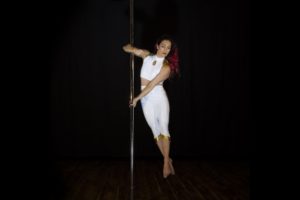Birds of Paradise is a new art installation that seeks to use pole dancing as a vehicle to tell the story of a post-energy-crisis world. Lauren Mardsen—who came up with the idea and directed, filmed, and edited the video installation—says that she was inspired by a friend displaying her pole-dancing skills.
“I really got inspired by the aesthetics of it, much less from a kind of exotic dancing perspective,” says Mardsen. “The athletic part of it, it just blows my mind how they defy gravity and conjure energy from I don’t even know where.”
Mardsen says that looking at the shape of some of the movements began to conjure up images of things in the world around us—tower cranes, pump jacks, wind turbines—and she wonders if anyone else has ever seen pole dancing and been reminded of the resource-extraction world.

“I lived in California for a number of years, which is a place that has a very audacious energy infrastructure,” says Mardsen. “Nuclear power plants, the giant California aqueduct—there’s kind of all these big infrastructure projects that really show how we support ourselves with the land and its resources in a way that we don’t see as much in Canada.”
The world of resource management, with the constant questions that exist about its limitations, is a popular topic; Mardsen believes that the subject matter is something that could be interesting to anyone.
“I kind of wonder how you could not be interested in it, as a sentient human being in the world today,” she says, “because it seems to be ever-present, and we can see the world changing before our very eyes. I don’t know how you could not be invested.”
The project is a collaborative effort that Mardsen says couldn’t have been accomplished without the talent and ingenuity of the dancers involved.
“I think a lot about how we’re going to deal with the changing landscape—the political landscape, but also the natural one. Who of the human species would survive and how will we struggle to adapt?” says Mardsen. “If we were ever to be an adaptable creature in the future, pole dancers might be the ones who could survive. Something about their strength and fortitude really impresses me.”
A large part of art has always been social commentary; Mardsen says that she’s not trying to say something as much as she is trying to help her viewers come to conclusions of their own.
“I don’t think that art in any way makes policy,” says Mardsen. “I don’t think that it actually solves problems, but what it allows us to do is create new images about these very confusing and sometimes confounding situations that we find ourselves in, and I think it has an indirect effect on helping people understand what their values are in relation to that image or that sound or whatever the art is. So it’s meant to kind of tease it out, or, at the very least, point to the complexity of it.”
The exhibit features video installations of performances, with several dancers telling interwoven stories about the post-energy-crisis world. It also features some strategically placed objects, which Mardsen also considers performers.
“It’s interesting to me to look at how things perform—how an object might perform or how an image might perform,” says Mardsen. “Obviously we have real performers, but, looking at some of the more landscape-based infrastructure and looking at how these things perform as well, I’m starting to have this view of the world like everything is constantly performing.”
Birds of Paradise
Until Saturday, April 22
Deluge Contemporary Art,
636 Yates Street
deluge.ws
